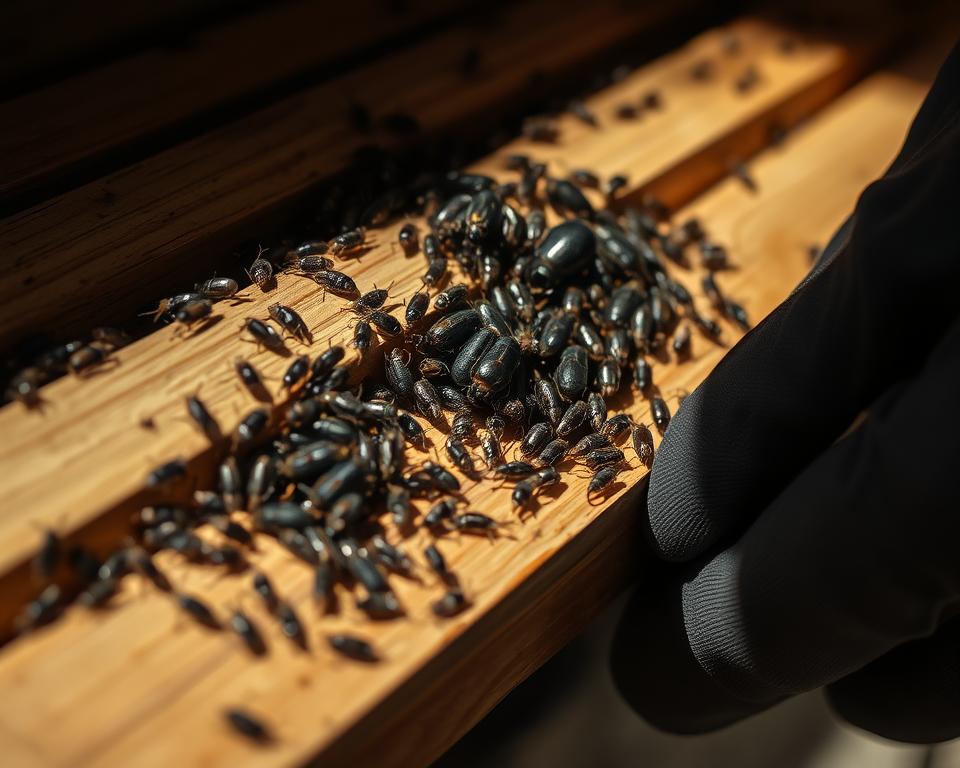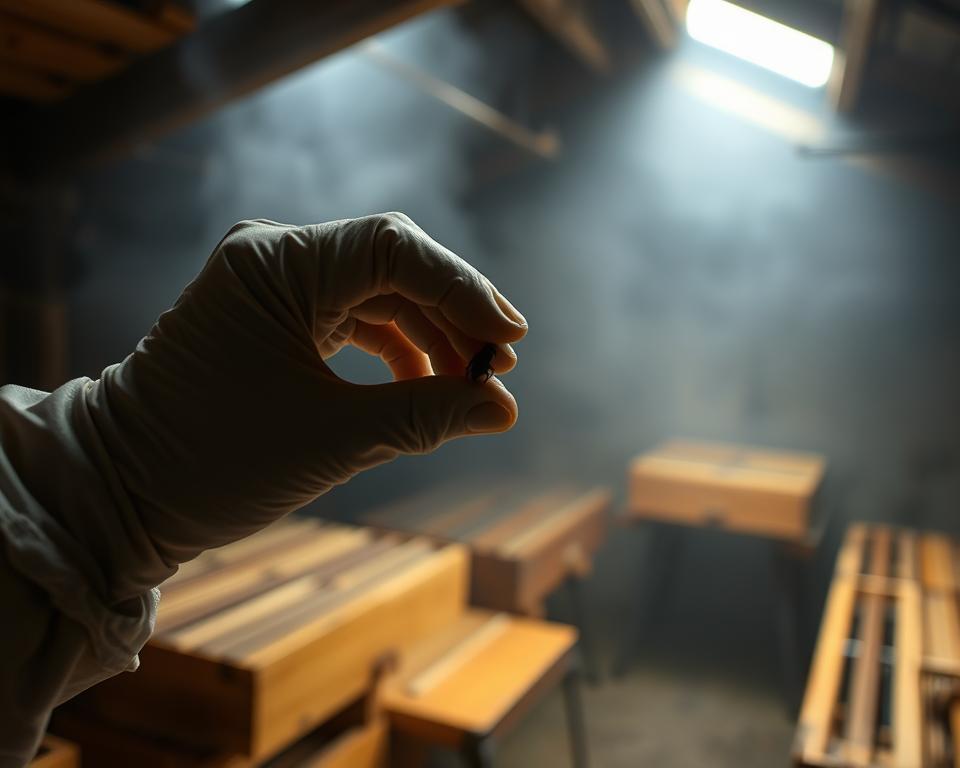As a beekeeper, you know that honey production can be severely impacted by pests. The small hive beetle is a big threat. These tiny pests can damage your hive and upset the bees’ social structure.
Effective management of these pests is key for your hive’s health and honey production. In this article, I’ll share important strategies for controlling small hive beetles. This will help keep your bees healthy and your honey production successful.
Key Takeaways
- Understanding the importance of small hive beetle management
- Identifying effective strategies for controlling these pests
- Maintaining hive health through integrated pest management techniques
- Protecting honey production from the impact of small hive beetles
- Ensuring the overall well-being of your bees
Understanding the Small Hive Beetle
Knowing about the small hive beetle is key to keeping bee colonies safe. This pest can harm bees and lower hive productivity.
What is the Small Hive Beetle?
The small hive beetle (Aethina tumida) is a pest that attacks bee colonies. It comes from sub-Saharan Africa and is now found in North America and Australia. Adult beetles are small, dark, and can fly, making them a threat to new colonies.
Lifecycle of the Small Hive Beetle
The lifecycle of the small hive beetle has four stages: egg, larva, pupa, and adult. Female beetles lay eggs in the hive, often in cracks. The eggs hatch into larvae that eat honey, pollen, and bee brood, causing damage. The larvae then leave the hive to pupate in the soil.
Knowing the lifecycle helps beekeepers control the beetles. For example, knowing when larvae leave the hive helps set up traps.
Signs of Infestation
Spotting small hive beetle infestations early is important. Look for:
- Beetle eggs or larvae in the hive
- Adult beetles flying or hiding in the hive
- Bad hive products, like fermented honey
- Bees acting sluggish or stressed
Regular checks are key to catching these signs early. Beekeepers should watch for any unusual hive activity.
| Signs of Infestation | Description |
|---|---|
| Beetle Eggs or Larvae | Found in the hive, often in cracks or on combs |
| Adult Beetles | Seen flying around the hive or hiding within |
| Hive Product Deterioration | Fermented honey, damaged combs |
Understanding the small hive beetle’s nature, lifecycle, and signs of infestation helps beekeepers protect their colonies. Using natural remedies and preventive steps can greatly reduce infestation risks.
The Importance of Small Hive Beetle Control
Small hive beetle control is key for beekeeping. It keeps bees healthy and the business running smoothly. As a beekeeper, you must manage these pests well.
Impact on Hive Health
Small hive beetles can harm a bee colony. They damage the comb, eat honey, and ferment it. This weakens the colony and makes it more prone to diseases.
Severe infestations can force bees to leave their hive. This can lead to losing the colony. It’s vital to use small hive beetle treatment options to keep the colony healthy.
Economic Consequences for Beekeepers
Not controlling small hive beetles can hurt a beekeeper’s wallet. Beetles eat honey and damage the comb, reducing honey production. This cuts into the beekeeper’s income and lowers apiary productivity.
Replacing lost colonies and damaged equipment is expensive. Using small hive beetle infestation solutions helps avoid these costs. It protects the beekeeper’s financial interests.
In summary, controlling small hive beetles is vital for bee colony health and beekeeping success. By understanding its importance and using effective methods, beekeepers can keep their apiaries thriving.
Prevention Techniques for Small Hive Beetles
As a beekeeper, stopping small hive beetle infestations is vital for healthy bees. You need regular checks, strong colonies, and good hive care.
Regular Hive Inspections
Checking your hives often is key to catching beetles early. I suggest inspecting every 7 to 10 days when beetles are most active. Look for small, dark beetles or their young in the hive.
Focus on the hive floor and walls, as beetles like to hide there. Also, watch for signs of stress or disease in the bees. Early detection helps you act fast and prevent big problems.
Maintaining Strong Colonies
Healthy, strong colonies fight off beetles better. Make sure your bees have a healthy queen and enough food. Check for queen and nutrition problems often.
Also, keep hives far apart and well-ventilated. This reduces stress on the bees and helps them fight off beetles. A well-managed colony is your best defense.
Hive Management Practices
Good hive management stops beetles. Keep your apiary clean and tidy. Remove any debris or dead bees around the hives, as beetles are attracted to them.
Use beetle traps in the hive and make sure it’s sealed tight. These steps help lower the chance of infestation and keep your bees safe.
Chemical Control Options
When prevention fails, beekeepers turn to chemicals to fight Small Hive Beetles. Prevention is best, but sometimes chemicals are needed to keep the hive safe.
Common Pesticides for Beetle Control
Many pesticides can control Small Hive Beetles. Each has its own active ingredients and how it works. Here are some common ones:
- Coumaphos: An organophosphate that fights various pests, including Small Hive Beetles.
- Pyrethroids: Synthetic versions of natural insecticides, good against many pests.
- Fipronil: A broad-spectrum insecticide for Small Hive Beetle control.
Knowing how these ingredients work is key to effective treatment.
Application Techniques
How you apply chemicals is critical for success and safety. Methods include:
- Direct Application: Putting the pesticide directly in the hive or on the beetles.
- Hive Treatment: Treating the hive to make it hard for beetles to survive.
Always use the pesticide as directed by the manufacturer.
Safety Precautions
When using chemicals, safety comes first. Important steps include:
- Protective Gear: Wear clothes, gloves, and masks to avoid exposure.
- Environmental Considerations: Think about the environment and how to protect it.
Here’s a quick guide to safety and application in a table:
| Safety Precaution | Application Technique | Purpose |
|---|---|---|
| Wear protective gear | Direct application | Minimize exposure to pesticides |
| Follow manufacturer’s instructions | Hive treatment | Ensure effective treatment and safety |
| Minimize environmental impact | Targeted application | Protect the environment and bees |
Understanding chemical controls, how to apply them, and safety measures helps beekeepers fight Small Hive Beetles. This way, they can protect their hives.
Natural Control Methods
Natural remedies are key in controlling small hive beetle infestations. They help keep bees and the environment safe. Beekeepers should try these methods to keep hives healthy.
Essential Oils
Essential oils are known for repelling or killing small hive beetles. Some of the most effective essential oils include:
- Tea tree oil
- Lavender oil
- Lemongrass oil
These oils can be applied directly to the hive. Or, they can be used with other natural methods. But, it’s important to dilute the essential oils properly to protect the bees.
Beneficial Nematodes
Beneficial nematodes are tiny worms that attack and kill small hive beetle larvae. They are a biological control method. By applying them to the soil around the hive, you can stop beetle larvae from becoming adults.
| Beneficial Nematode Species | Target Stage | Application Method |
|---|---|---|
| Steinernema carpocapsae | Larvae | Soil application |
| Heterorhabditis bacteriophora | Larvae | Soil application |
Traps and Baits
Traps and baits are great for managing small hive beetles. Homemade traps can be made from common items. Commercial traps are also available.
Some common types of traps include:
- Corrugated cardboard traps
- Oil-based traps
- Fermentation traps
These traps attract and trap beetles. This helps lower their numbers in the hive.
Monitoring for Small Hive Beetles
Effective small hive beetle management starts with diligent monitoring. As a beekeeper, it’s important to watch your beehives closely. This helps you spot infestations early. Early action can prevent serious damage to your colonies.
Setting Up Monitoring Stations
To monitor small hive beetles well, set up stations in your apiary. Place traps or tools in key spots around the hives. For more info, check the Ontario government page on small hive beetles.
When setting up stations, remember these tips:
- Put traps near the hive entrance where beetles are most likely to be found.
- Use a mix of trap types to catch more beetles.
- Regularly check traps to see how many beetles are present.

Identifying Infestation Levels
After setting up stations, accurately identify infestation levels. Count the beetles in your traps and look for signs in the hive.
Here’s a simple guide to assess infestation levels:
| Infestation Level | Number of Beetles Caught | Signs within the Hive |
|---|---|---|
| Low | 1-5 beetles per trap | Few signs of damage or stress |
| Moderate | 6-20 beetles per trap | Some damage to combs, slight stress |
| High | More than 20 beetles per trap | Significant damage, high stress, or absconding |
Regular monitoring and accurate infestation assessment help you control beetle populations. This protects your colonies.
Integrated Pest Management (IPM)
IPM is a detailed way to handle small hive beetles. It mixes different methods for the best results. This way, beekeepers can lower beetle numbers and protect the environment.
Combining Control Methods
Good IPM uses chemicals, natural methods, and cultural practices together. Chemical controls include pesticides made for small hive beetles. Natural controls like essential oils and beneficial nematodes are safer. Cultural controls mean changing beekeeping habits to stop beetles, like keeping strong colonies and clean hives.
- Regular hive checks to spot beetle problems early
- Traps and baits to catch and remove beetles
- Keeping the hive clean and well-ventilated
Benefits of IPM
IPM for small hive beetles has many advantages. It combines methods for better beetle control and less pesticide use. This approach also helps the environment by keeping hives healthy.
Some main benefits of IPM are:
- Less chemical use, better for the planet
- More effective in fighting beetles
- More sustainable beekeeping
Using IPM, beekeepers can keep their hives healthy for a long time. This method helps both the beekeeper and the bees, making beekeeping better for everyone.
Seasonal Considerations
Controlling small hive beetles requires understanding seasonal changes. Beekeepers must know how these pests change with the seasons. This knowledge helps in adjusting control strategies.
Spring Management Tips
Spring is key for beekeepers to check their hives and clean up. Look for small hive beetle signs and act fast to stop their growth.
- Inspect colonies regularly to detect early signs of infestation.
- Ensure colonies are strong and healthy to resist beetle invasions.
- Clean and maintain equipment to reduce hiding places for beetles.
By following these tips, beekeepers can lower the risk of beetle infestations in warmer months.
Summer Infestation Risks
Summer is a high-risk time for small hive beetle infestations. Beekeepers need to stay alert and use strategies to fight these risks.
“The key to managing small hive beetles is understanding their lifecycle and being proactive.” – Expert Beekeeper
Effective summer strategies include:
| Strategy | Description | Benefits |
|---|---|---|
| Monitoring | Regularly check for signs of beetles | Early detection, reduced damage |
| Traps | Use beetle traps within the hive | Reduced beetle populations |
| Cultural Controls | Maintain strong, healthy colonies | Improved colony resilience |
Fall Preparations
As fall comes, beekeepers must prepare their colonies for winter. This means keeping colonies strong and healthy. It also means stopping small hive beetle infestations.
I recommend:
- Reducing hive entrances to prevent robbing and beetle invasion.
- Tightening hive configurations to minimize spaces where beetles can hide.
- Treating for beetles if necessary, using approved methods.
By focusing on seasonal control, beekeepers can better protect their colonies. This ensures a healthy bee population all year.
The Role of Temperature and Humidity
To control small hive beetles organically, knowing how temperature and humidity affect them is key. These factors play big roles in their life cycle and how active they are.
As a beekeeper, it’s important to know that small hive beetles do best in certain conditions. Ideal temperatures for their development range from 64°F to 90°F (18°C to 32°C). They reproduce best at about 82°F (28°C).
Ideal Conditions for Beetles
Temperature affects the lifecycle of small hive beetles. Warmer temperatures speed up their growth. Here’s how temperature impacts their life stages:
| Temperature (°F) | Development Stage | Duration |
|---|---|---|
| 64-70 | Egg to Larva | 3-4 days |
| 75-80 | Larva to Pupa | 2-3 days |
| 82 | Pupa to Adult | 7-10 days |
Humidity is also important. Beetles do well in humid places. Keeping the hive environment dry can help prevent infestations.
Managing Hive Environment
Beekeepers can make the hive less appealing to small hive beetles by managing the environment:
- Ensure proper ventilation within the hive to reduce humidity.
- Monitor temperature fluctuations and take steps to maintain a stable environment.
- Use techniques like shading the hive during peak summer months to reduce temperature.
Experts say, “Managing the hive environment is key to controlling small hive beetles.”
“By understanding and manipulating environmental factors, beekeepers can significantly reduce the risk of infestation and promote a healthier hive.” – Beekeeping Journal

By knowing the ideal conditions for small hive beetles and managing the hive environment, beekeepers can control these pests organically. This approach keeps the hive healthy and supports sustainable beekeeping.
Education and Resources for Beekeepers
Learning how to control small hive beetles is essential for beekeepers. There are many resources available to help. Having the right information and tools is key to keeping colonies healthy.
Workshops and Conferences
Workshops and conferences are great for beekeepers. They offer hands-on learning and the latest on controlling small hive beetles. You can learn from experts and other beekeepers.
“Attending beekeeping conferences has been a game-changer for my apiary. The knowledge and techniques I’ve gained have significantly improved my colony’s health.”
Some top conferences include the American Beekeeping Federation Conference and regional seminars.
Books and Online Resources
Books and online resources are also valuable. They cover everything from basic beekeeping to advanced pest management. This helps beekeepers stay up-to-date and adapt to new challenges.
- “The Beekeeper’s Handbook” by Diana Sammataro and Alphonse Avitabile
- “Honey Bee Colony Health: Challenges and Sustainable Solutions” edited by Diana Sammataro
- Online forums like BeeKeeping Forum and Honey Bee Suite
These resources provide a wealth of information on controlling small hive beetles. They help beekeepers stay informed and adapt to new challenges.
| Resource Type | Description | Benefit |
|---|---|---|
| Workshops | Hands-on training and demonstrations | Practical experience with latest techniques |
| Conferences | Presentations by experts in beekeeping | Access to cutting-edge research and networking |
| Books | Comprehensive guides on beekeeping and pest management | In-depth knowledge on various aspects of beekeeping |
| Online Resources | Forums, articles, and webinars | Convenient access to a wide range of information |
By using these educational resources, beekeepers can better manage small hive beetles. This ensures the health and productivity of their colonies.
Community Support for Beekeepers
Managing small hive beetles is not just about individual effort. It’s also about being part of a supportive community. The challenges posed by these pests can be significant. Having a network of fellow beekeepers can make a substantial difference.
One of the primary ways beekeepers can come together is through local beekeeping associations. These organizations provide a platform for beekeepers to share their experiences. They also learn from one another and collaborate on solving common problems, including managing small hive beetle infestations.
Local Beekeeping Associations
Local beekeeping associations are invaluable resources for beekeepers. They often host meetings, workshops, and conferences. Members can exchange information on best practices for controlling small hive beetles.
Being part of a local beekeeping association can also provide emotional support. Beekeeping can be stressful, and dealing with pests like the small hive beetle is no exception. Sharing experiences and advice with others who face similar challenges can be incredibly reassuring.
Knowledge Sharing and Collaboration
Knowledge sharing is at the heart of any beekeeping community. By collaborating and sharing their findings, beekeepers can develop more effective solutions. This collaborative approach is important when managing small hive beetles.
For instance, beekeepers can share their experiences with different control methods. They can discuss the effectiveness of using essential oils or beneficial nematodes. This exchange of information helps beekeepers make informed decisions about their beekeeping practices.
In conclusion, community support is a critical component of successful beekeeping. By engaging with local beekeeping associations and participating in knowledge sharing, beekeepers can enhance their ability to manage small hive beetles. This helps maintain healthy hives.
Conclusion: Best Practices for Small Hive Beetle Control
Managing small hive beetles requires knowing the pest, taking preventive steps, and monitoring. A proactive and integrated approach helps protect hives. This ensures the health and productivity of bees.
I’ve shared strategies for controlling small hive beetles. These include regular hive checks, keeping colonies strong, and using chemical and natural treatments. These methods can greatly lower the risk of infestations.
By using these strategies together and staying updated, beekeepers can create a solid plan. This plan is key to keeping bees healthy and a beekeeping business thriving.
